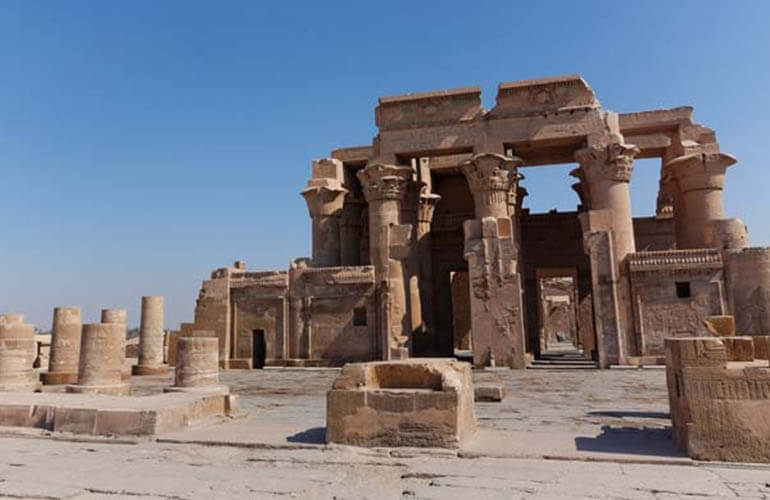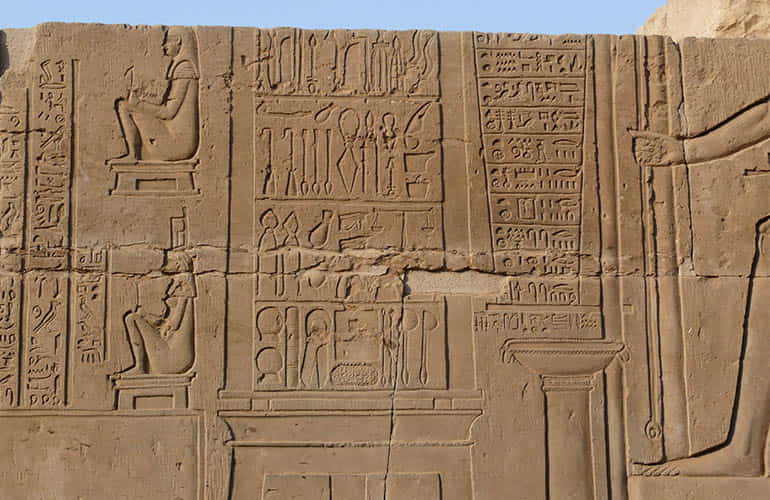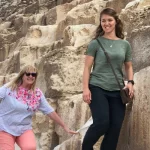Kom Ombo Temple, Luxor
About forty kilometers north of Aswan and a few meters from the bank of the Nile on the east bank stands the Kom Ombo temple, perched on a small mound of stone and sand. Not only its supreme Ptolemaic architecture is outstanding: also the myths that were woven around its construction, and its destruction.
The name Kom Ombo is derived from the ancient Egyptian site of Ombos, derived from the ancient Egyptian word “nwbt”, which means gold. In ancient Egypt, this city was important because it controlled the routes of the commercial caravans that went to Nubia through the valley of the Nile. That’s why all the powers that once controlled the country, kept a military fortification in Ombos (Kom Ombo).

Temple of Kom Ombo facts
The Kom Ombo temple is one of the most famous temples in Egypt because it is completely symmetrical. It has two entrances, two Hypostyle Halls -covered by columns- and two sanctuaries. This is because the temple is dedicated to two different gods: Horus – or Haroeris – and Sobek. Although in many ways it is a double temple, it has several rooms and enclosures for common use.
The temple was started at 2nd-century b.C., during the Ptolemaic dynasty, and different elements were added during Roman domination. Therefore you will find many reminiscences of the Greco-Roman style in its architecture. For instance, the pylon at the entrance was erected by Emperor Augustus and has different bas-reliefs showing Roman emperors making offerings to the Egyptian gods.
Kom Ombo temple surgical instruments
Medicine in ancient Egypt was highly developed, although always influenced by religion and magic. Doctors, swnw, were specialized, knowing each other already from the Ancient Empire, the figure of the dentist, for example. Although Herodotus states in his writings, that there was no medical specialization, but that all doctors knew how to deal with everything.
There were three possible diagnoses of the diseases, according to the medical criteria, which were
1- “This is a disease I know and will cure,” when they knew a remedy for it.
2- “This is a disease I know and will treat,” when they were treating, not sure of the results.
3- “This is a disease I don’t know and won’t treat,” when they were sure it was an incurable or terminal disease.

On the outside of the temple, you can find a superb relief that shows the god Imhotep with the medical instruments of the time and various texts on the art of medicine. You will be surprised to see that the medical instruments of the time are very similar to those used today.
The scene related to medicine is the one that shows the emperor Trajan, before the God Imhotep, who was the architect of the step pyramid, the 1st Egyptian pyramid. Imhotep was also a priest and a renowned physician. That is why we find the consecration as God of medicine in this temple, with Trajan on his knees giving the offerings to a seated Imhotep.
Utensils used by medicine, sterilizing pools and the representation of seated Isis to facilitate giving birth for women are some of the details of this beautiful scene.
Kom Ombo temple map
The main temple is surrounded by two stone walls, so it has two deambulatories. Two chambers and a central access staircase were embedded in the back wall of the inner wall.
The Temple is unique in his design since it actually consists of two symmetrical temples aligned along a longitudinal axis and every detail of the construction is reproduced identically in each of them. It has two pylons, two entrances, two courtyards, two Hypostyle halls, and two sanctuaries. The reason is that on one side the god Horus was worshipped and on the other side Sobek was worshipped.
The one dedicated to Haroeris is located to the north and the one dedicated to Sober is located to the south of the complex. In both you can still see the black diorite tables dedicated to the offerings. This temple was called “House of the Crocodile” and “Castle of the Falcon”.
There are two triads in the temple, one is attributed to Haroeris, his wife Tasenetnefret and his son Panebtawy, and the other is attributed to the god Sobek, god of fertility and creator of the world with Hathor and Khonsu.
Kom Ombo temple calendar
The calendar is the numerical representation that the Egyptians used to represent their days, months and years. Its discovery was very important to know the Egyptian calendar.
The calendar is divided into three seasons: Flood, sowing, and harvest. Each season has 4 months and each month 3 weeks of 10 days. The 30 weeks for 12 months add up to a total of 360 days. The 5 missing days until arriving at the 365 that the year has are the calls forgotten days that correspond to the 4 main gods, Isis, Osiris, Seth and Nephthys, and to the god Horus.
It should be noted that this scene in the temple of Kom Ombo served to understand what was their number system and hence its importance in the Egyptian world.





